Bees In Schools
I firmly
believe that if you inspire children today to love animals and the wonders of
nature, then when they grow up, they’ll be better citizens, and they’ll seek to
preserve the natural world for future generations.
Schools have a fantastic role to play, so I was delighted to learn of a school in the UK, with a wonderful ethos and inspiring initiatives.
Ysgol San
Sior (St.George’s School) is a primary school in Llandudno in North Wales. The headmaster (Mr Ian Jones) decided to use
bees and animals as a means of improving standards in numeracy, literacy and life skills. (A link to an introductory letter written by the headmaster is listed at the end of this article - it's well worth a read!).
Bringing bees and beekeeping into school
 The children are very much involved in beekeeping too.
The children are very much involved in beekeeping too.
This innovative
school has ten beehives.
The staff underwent beekeeping training, but it’s not just the staff who care for the bees. The children are very much involved in beekeeping too, with the school having purchased a number of beekeeper suits for children so that the pupils can help out with the bees and view the honey bees at close quarters.
To enhance this experience
further, they have even installed a webcam in one of the hives in order to
monitor the daily activities of all the bees.
The school now sells honey, and it's highly regarded too, with children's TV presenter, Matt Baker saying:
"This is amongst the finest honey I have ever tasted".
 The honey produced by the bees at Ysgol San Sior is very fine.
The honey produced by the bees at Ysgol San Sior is very fine.
The honey is sold at local events, such as
the yearly honey fair at the lovely nearby town of Conwy. The children help with the stall, which of
course, helps to expand the children’s learning experience further.
The
beekeeping project has proven so successful that the local beekeeping
organisation that has assisted the school (Conwy Beekeepers –
Gwenynwyr Conwy) is aiming to establish a few more beekeepers in other
selected schools in the Conwy district.
Hands on education about pollination and growing food
 The children are being taught the connection between the bees, the flowers, pollination and honey.
The children are being taught the connection between the bees, the flowers, pollination and honey.
This direct involvement with bees no doubt helps children understand the link between the flowers around them, and food that ends up on their plates.
The creation of a bee-friendly garden including nectar-rich plants and an apple orchard within the school premises, makes it easy for children to observe pollination first hand.

Expanding the learning experience
If all this is not enough, the school grows plants to raise extra money for school funds, and sells eggs from the chickens to
local shops and a local restaurant. The
school has 150 hens, which produce about 20,000 eggs each year. With the fruit and vegetables they grow, the
children also make and sell chutney.
 The children help with the chickens.
The children help with the chickens.
Working with animals
 The children take photographs of the animals and creatures in the menagerie, and these are made into greeting cards.
The children take photographs of the animals and creatures in the menagerie, and these are made into greeting cards.
In addition
to the bees, a farm and chickens, the school has a menagerie. Animals they keep include: tortoises; tenrecs; reptiles and invertebrates such as moths, snails and beetles.
As well as learning to care for these animals and creatures, the children take photographs and use the images to create greeting cards which are sold from the school and local festivals or fairs.
The children also start the day with an animal linked to
the book Lost Words by Robert Macfarlane.
Celyn, the 'reading dog'
Being a dog
lover, I find it especially heart-warming that the children have a ‘reading dog’ – a
labradoodle called Celyn. The children practice by reading to Celyn, and apparently, Celyn is a very good listener!
 Celyn is a very good listener.
Celyn is a very good listener.
It
seems Celyn enjoys the experience of being read to as much as the children
enjoy the experience of reading to him.
As a result of this initiative, the reading proficiency and confidence of the pupils has improved because Celyn listens non-judgementally and without interruption, which is particularly beneficial for shy pupils.
I can imagine
it also makes reading much more enjoyable - I'm sure there would have been a stampede to read to Celyn if he had been at my school when I was a child!
 After a hard day's work it's time for a snooze.
After a hard day's work it's time for a snooze.
How do these
activities help with traditional and broader parts of the school learning
curriculum?
Aside from
the obvious (learning the value of pollinators and the link between pollinators, biodiversity and food), these fabulous initiatives create a myriad innovative learning
experiences. Just a few examples:
- calculating the profit from chutney and honey sales;
- counting and comparing egg production one year with egg production from another year;
- business skills through creating products to sell and serving customers on stalls;
- animal husbandry (and empathy!);
- creative
cooking skills.
I wasn’t surprised to learn that the children are very passionate about the whole project and, according to a 2017 report by Estyn (the Welsh Government school inspection organisation) the children discuss the project ‘with great confidence and maturity’.
Recognition
The school has attracted very positive attention, including:
- a visit from HRH, Prince Charles who visited the school;
- being featured twice in the BBC television programme, Countryfile;
- a number of enterprise and 'green' awards.
 HRH, Prince Charles talking with the children.
HRH, Prince Charles talking with the children.
Verdict
I’m incredibly impressed with this school, which is why I am so keen to share information about it. It sets an outstanding example to other schools that I hope will be repeated elsewhere, not only across the UK but internationally.
It is also a wonderful example of how a local group of beekeepers can get involved with a school and help to introduce them to the wonderful world of bees.
I would be very
interested to learn of comparable initiatives via my 'contact me page'.
Some bee-related words in Welsh
 Honey bee foraging on sneezeweed.
Honey bee foraging on sneezeweed.
Wales has its own indigenous language, so for fun, here are some bee-related Welsh words:
Bee = gwenynen (bees = gwenyn)
Bumble bee = cacynen
Honey bee = gwenynen
Beehive = cwch gwenyn
Beekeeper = gwenynwr (beekeepers = gwenynwyr)
Apiary = gwenynfa
Flower = blodyn
Nectar = neithdar
Pollen = paill
Pollination = peilliad
Pollinate = peillio
Beeswax = cwyr gwenyn
Honeycomb = crwybr gwenyn, diliau
A swarm = haid
To swarm = heidio
Related links:
School website: https://www.sansior.wales/ and letter from the headmaster - well worth reading:
https://www.sansior.wales/letter-from-the-head
More:
Conwy Beekeepers - http://www.conwybeekeepers.org.uk/
National Beekeeping Centre - www.beeswales.co.uk
Welsh Beekeepers Association - www.wbka.com
More articles about bees
- The 4 Key Stages Of The Bee Life Cycle - For All Bee Species The Bee Life Cycle Explored: A look at the different life stages of honey bees, bumble bees and solitary bees.
- What Is A Bee? Is A Bee An Insect, Bug, Invertebrate, Animal, Mammal? What is a bee? Are bees insects and are they bugs or a type of fly? Are bees animals and if so, are they mammals? Are bees invertebrates? Answers here.
- Types of Bees: The different species, families and generas of bees Explained here: different types of bees: bumblebees, carpenter, mason, leaf cutter, honey bees and more.
- Natural Enemies Of Bees Natural Enemies Of Bees, from spiders to other insect parasites.
If you found this page helpful or interesting, I'd really be grateful if you would share it with others - if not this page, perhaps another, such as Gardening For Bees.
Thank you so much :) .